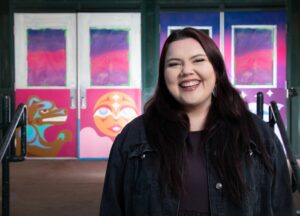Elinor Atkins’ illustrations are throughout The Girl Who Loved the Birds, a new children’s book that the former Camosun student says takes on some heavy subjects. Atkins—who took Indigenous Studies at Camosun in 2018 and 2019 and now lives in Fort Langley—says that the book, the third in a series of Kwantlen legends by author Joseph Dandurand, focuses on teaching the younger generation about subjects like the importance of respecting our environment and land and how to cope with the grief of losing someone close.
“This is a book written by the wonderfully talented Joseph Dandurand, who I have always looked at like a parental figure in my life,” says Atkins. “He’s always been around, I grew up with him, and I think he had the chance to see me grow as an artist, and took the shot at giving me that opportunity. I’ll forever be grateful to him for that, because I did a few of his book covers now, and then I’ve done two children’s books with him… It’s a story about a young girl and it teaches that if you give back to the land and to the Earth that you will receive back as well. It teaches respect, respect and kinship to the land and connection to the land.”
Atkins says the main thing that drew her to the story of The Girl Who Loved the Birds is its handling of topics that are taboo in children’s books, such as death and loss.

“I also think it’s a great story that teaches children about losing people or having someone pass away in a very gentle way where it’s not harsh, and I think that’s something that a lot of kids need,” she says. “Because even I’ve recognized when working in schools, I’ve brought up losing my grandparents, and then I’d have all these kids shooting up their hands wanting to talk about how they’ve lost their grandparents as well. I feel like losing people and talking about death is kind of taboo sometimes but this book relays it in such a gentle way.”
Atkins says that the main thing she likes about art is the very humanistic nature of it.
“I think what I love about art itself is that it’s a very healing thing,” she says. “It creates a lot of understanding, it creates the ability to understand other people’s perspectives in a gentle way, it’s also spiritually uplifting. And I also think that it helps me work towards being my highest version of myself, through doing my artwork. It’s also… I wasn’t always the greatest example for our younger generation. I went through a lot of addiction, a lot of turmoil, a lot of inner stuff that I had to battle but now that I do my artwork I feel that I actually can be a good example for the younger generation, showing them that you can find ways to cope with hard things in healthy ways and that’s what I do through my art and that’s how I’ve healed, through doing my artwork.”
Atkins says that while she wasn’t at a good place while she was at Camosun she still had a great experience at the college.
“I was dealing with a lot of personal stuff, like family stuff, losing people, so I wasn’t in the greatest headspace,” she admits. “I also have an autoimmune disorder, so I was dealing with all the stuff that comes along with that. So, I wasn’t always the most dedicated to my schooling, but they were always so patient with me, and that’s something that I remember.”
